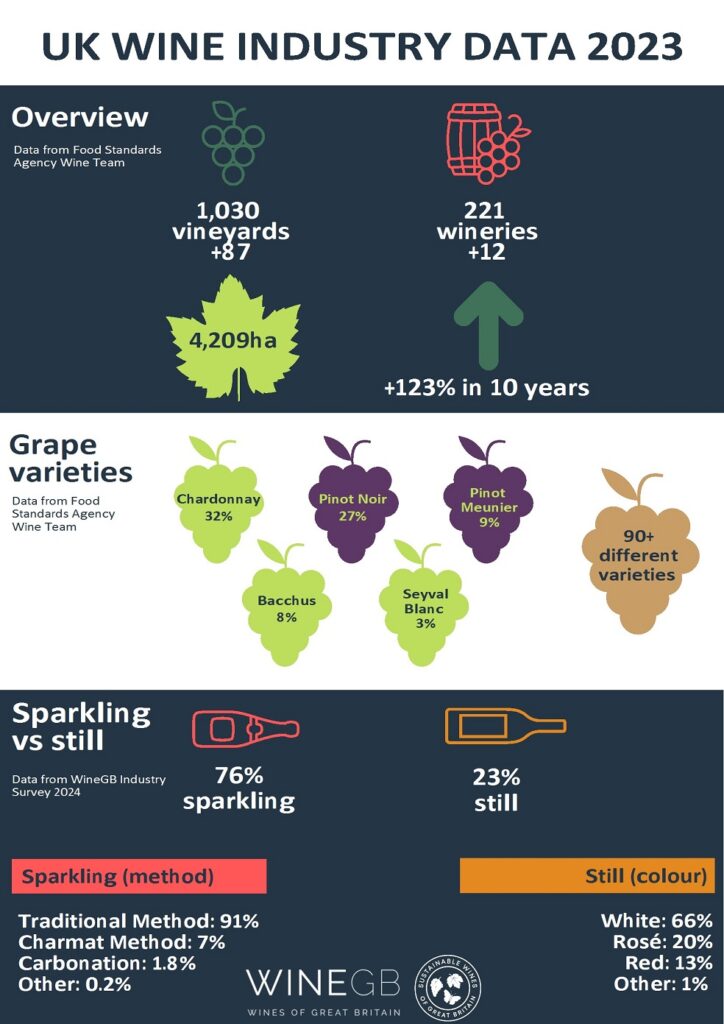As part of its Growth Series releases, WineGB can reveal that there are 1,030 vineyards in the UK, up 9.2% since the last annual report, according to new figures from the Food Standards Agency’s Wine Team. In addition, sales of English and Welsh wines grew by 10% last year compared to 2022.
Chrome and production
In 2023, 87 new vineyards were registered, bringing the total to more than 1,000 for the first time. Government data also shows that the number of wineries has increased from 209 to 221 and the total area under vines now stands at 4,209 hectares, representing a growth rate of 123% in 10 years.
Production returns submitted to the Food Standards Agency’s Wine Agency Standards Team have confirmed initial estimates in the WineGB Harvest Report that 2023 was a record year. Official production figures for 2023 totalled 161,960.84 hectolitres, equivalent to 21.6 million bottles, up 77% on 2022. While last year’s volume growth was significant, the UK’s marginal climate will continue to deliver volatility in the crop with the five-year average rising from 10.7 million to 12.4 million bottles.
sales
WineGB data shows that sales of English and Welsh wine continue to grow sustainably and manageably as new vineyards come into production. Sales rose by 10% last year to 8.8 million bottles. Over the five-year period since 2018, sales have been rising steadily.
Sparkling wine sales have increased 187% since 2018, from 2.2 million bottles to 6.2 million bottles in 2023. Still wine sales have increased 117% over the same period, from 1.2 million bottles to 2.6 million bottles.
This growth is all the more impressive because it runs counter to the wider trend of declining wine consumption in the UK and globally.
WineGB has declared 2024 to be the ‘Year of Growth’ with the launch of the WineGB Growth Manifesto. With growth as its number one priority, WineGB is actively supporting the UK wine industry to accelerate its expansion. This is being done through targeted support for wine tourism, the UK market and exports as well as the creation of working groups to harness the collective expertise of the industry and develop a cohesive narrative to support sales. Through its presence at local and international trade fairs, WineGB is creating the framework that enables producers to find new ways to market.
The significant production volume achieved last year is reassuring as it will enable our emerging winemakers to build their reserve wine stocks for use in non-vintage sparkling and multi-vintage wines, and for the small but growing still wine category NV/MV. Reserve wines facilitate the creation of consistent products year after year. These wine stocks can take decades to develop, and they allow for greater wine complexity and more blending options for winemakers. As an emerging industry, building these stocks remains very important. The increased future supply of wines will also open up new markets and sales channels, allowing wineries to meet and commit to more accounts and distributors/retailers with more and larger volume orders.
Over the past year, the mix of sales channels has stabilised, reflecting post-pandemic market dynamics. UK online sales have grown to 28% of total volumes (up from 22% in 2022). Exports continue to grow as a percentage of total sales, rising to 8%. Cellar door sales (17%), online producer sales (11%) and UK off-trade national accounts (30%) have remained steady, while there has been a slight decline in UK off-trade independent retail (6%).
WineGB data found that wineries producing more than 32,000 bottles per year were less reliant on direct-to-consumer sales and had a greater share of trade sales, particularly online. Small and medium-sized producers (up to 32,000 bottles) sell more wine direct-to-consumer and through independent retail, and due to volume constraints, sell only a small proportion through national trade accounts.
The UK’s sustained growth in wine is reflected in the diversification of vineyards, opening up the future market for different styles of wine. Government data shows that 51 different grape varieties were planted last year, with the UK now home to more than 90 grape varieties. While Chardonnay, Pinot Noir and Pinot Meunier still dominate the planting landscape, their share of plantings has fallen slightly from 71% of total plantings in 2021 to 68% in 2023. However, the top five varieties (Chardonnay, Pinot Noir, Pinot Meunier, Bacchus and Seyval Blanc) still account for the majority of new plantings (185ha), compared to the next ten varieties on 55ha and all other varieties on 49ha. The growth trend for hybrids continues, with these varieties now accounting for 8% of total plantings. Top hybrids include Seyval Blanc, Solaris, Rondo and Regent.
Grape varieties
Area and planting percentage Chardonnay 1,331 ha, 32% Pinot Noir 1,157 ha, 27% Pinot Meunier 379 ha, 9% Bacchus 324 ha, 8% Seyval Blanc 127 ha, 3% Solaris 110 ha, 3% Pinot Noir Bricus 73 ha, 2% Pinot Gris 69 ha, 2% Reichensteiner 67 ha, 2% Rondeau 66 ha, 2%
In terms of wine style and production methods, WineGB data reveals that 76% of wine produced in 2023 will be made into sparkling wine, 23% into still wine and 1% into other products such as vermouth. 91% of sparkling wine is made using the traditional method, 7% using charmat, 1.8% using carbonation and a small portion (0.2%) using other methods. For still wine, a higher proportion will be made into white wine (66%) compared to 2022, while the lowest proportion will be red wine (13%) with rosé remaining the same (20%).
Nicola Bates, chief executive of Wines of Great Britain, the trade body for the English and Welsh wine industry, said: “This is our year of growth and passing the 1,000 vineyard mark is a real milestone for our industry and reinforces our position as the fastest growing agricultural sector in the UK.
“We are growing sustainably with our production, securing a 10% increase in sales, which is particularly notable given the wider decline in wine consumption in the UK. As consumers begin to feel more confident in the economy, they are likely to have more disposable income to discover our wines in pubs, bars and restaurants. We anticipate a wider relaunch that will support our future wines reaching new markets and new drinkers.
“The UK wine industry is a success story that has shown extraordinary growth and development over the past decade as a result of significant investment. The growth of vineyards and wineries is expected to continue at a rapid pace.”


